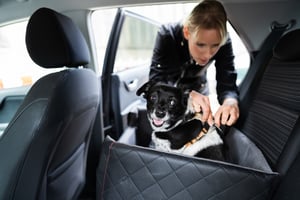 Pets are a big part of many families. More than 63 million households own a dog. Because they’re considered part of the family, they often accompany families during daily trips and vacations.
Pets are a big part of many families. More than 63 million households own a dog. Because they’re considered part of the family, they often accompany families during daily trips and vacations.
Depending on where you travel, allowing your dog to sit on your lap while driving may be illegal. Some states consider this a form of distracted driving and require pets to be in proper car restraints.
Here are the basic rules to follow when traveling with pets:
1. Don’t drive with your pet on your lap.
2. Never allow a pet to travel in the vehicle's front seat.
Doing either can lead to distracted driving, possibly resulting in injury or death.
Before you head out and travel with a pet you should consider these different options for restraining your dog as well as additional safety tips.
1. Always use the proper size pet carrier.
If you have a van or SUV, a pet crate or carrier is a nice option. Your pet and the carrier can be loaded through the tailgate. In addition, the carrier will sit on a relatively flat surface. Then, don’t forget to secure it. Be sure your carrier is the right size to allow your pet to stand, sit, turn around, and lie down.
2. Consider other options.
If a pet carrier doesn’t fit in your vehicle, consider other options to restrain your pet. The restraint that will work best for you depends on the size of your dog. These links provide some different options.
Sleepypod Official Store - Dog Car Safety Harness
Car Safety Items for Your Pet | PetMD
3. Practice.
Not planning your route leads to indecision, and indecision leads to distraction. If you’ve welcomed a new dog into your family, consider taking it on a test drive. Never assume your new pet enjoys car rides. Watch for signs of anxiousness and car sickness. These things can lead to distraction while you’re driving.
4. Allow plenty of travel time.
If you have a long drive ahead, allow for pit stops along the way. The American Veterinary Association recommends a stop every two to three hours.
5. Plan your overnight stays ahead of time.
Many hotels allow pets now, but while you’re driving isn’t the proper time to be searching for these hotels.
With proper safety equipment and planning, traveling with a pet can be safe and enjoyable for you, your family, and your pet.
Do you have any suggestions or information you’d like to share? I’d love to hear from you. Please share them in the box below!





